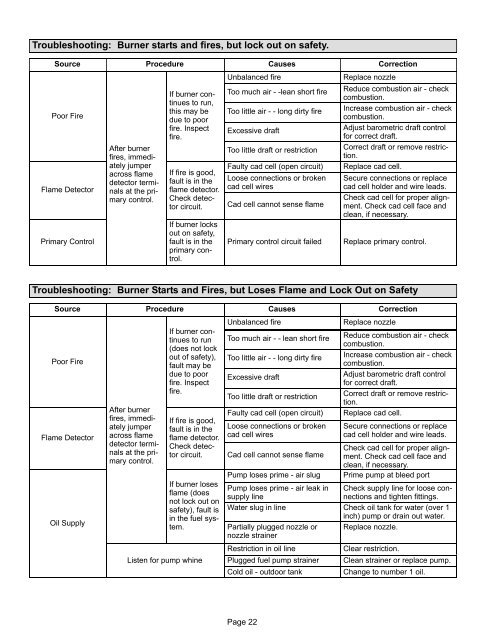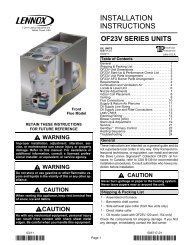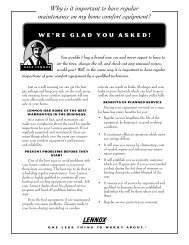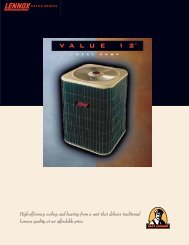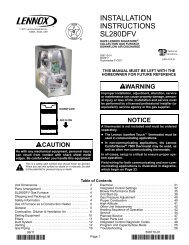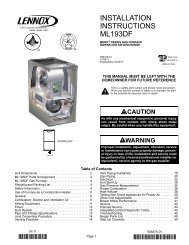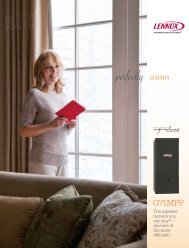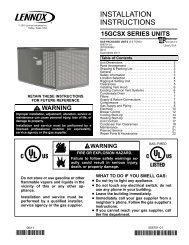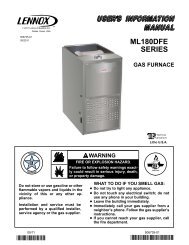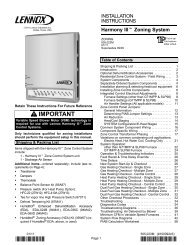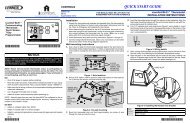ELO183B Oil Furnace Installation Manual - Lennox
ELO183B Oil Furnace Installation Manual - Lennox
ELO183B Oil Furnace Installation Manual - Lennox
You also want an ePaper? Increase the reach of your titles
YUMPU automatically turns print PDFs into web optimized ePapers that Google loves.
Troubleshooting: Burner starts and fires, but lock out on safety.<br />
Source Procedure Causes Correction<br />
Poor Fire<br />
Flame Detector<br />
Primary Control<br />
After burner<br />
fires, immediately<br />
jumper<br />
across flame<br />
detector terminals<br />
at the primary<br />
control.<br />
If burner continues<br />
to run,<br />
this may be<br />
due to poor<br />
fire. Inspect<br />
fire.<br />
If fire is good,<br />
fault is in the<br />
flame detector.<br />
Check detector<br />
circuit.<br />
If burner locks<br />
out on safety,<br />
fault is in the<br />
primary control.<br />
Unbalanced fire<br />
Too much air − −lean short fire<br />
Too little air − − long dirty fire<br />
Excessive draft<br />
Too little draft or restriction<br />
Faulty cad cell (open circuit)<br />
Loose connections or broken<br />
cad cell wires<br />
Cad cell cannot sense flame<br />
Primary control circuit failed<br />
Replace nozzle<br />
Reduce combustion air − check<br />
combustion.<br />
Increase combustion air − check<br />
combustion.<br />
Adjust barometric draft control<br />
for correct draft.<br />
Correct draft or remove restriction.<br />
Replace cad cell.<br />
Secure connections or replace<br />
cad cell holder and wire leads.<br />
Check cad cell for proper alignment.<br />
Check cad cell face and<br />
clean, if necessary.<br />
Replace primary control.<br />
Troubleshooting: Burner Starts and Fires, but Loses Flame and Lock Out on Safety<br />
Source Procedure Causes Correction<br />
Poor Fire<br />
Flame Detector<br />
<strong>Oil</strong> Supply<br />
After burner<br />
fires, immediately<br />
jumper<br />
across flame<br />
detector terminals<br />
at the primary<br />
control.<br />
If burner continues<br />
to run<br />
(does not lock<br />
out of safety),<br />
fault may be<br />
due to poor<br />
fire. Inspect<br />
fire.<br />
If fire is good,<br />
fault is in the<br />
flame detector.<br />
Check detector<br />
circuit.<br />
If burner loses<br />
flame (does<br />
not lock out on<br />
safety), fault is<br />
in the fuel system.<br />
Listen for pump whine<br />
Unbalanced fire<br />
Too much air − − lean short fire<br />
Too little air − − long dirty fire<br />
Excessive draft<br />
Too little draft or restriction<br />
Faulty cad cell (open circuit)<br />
Loose connections or broken<br />
cad cell wires<br />
Cad cell cannot sense flame<br />
Pump loses prime − air slug<br />
Pump loses prime − air leak in<br />
supply line<br />
Replace nozzle<br />
Reduce combustion air − check<br />
combustion.<br />
Increase combustion air − check<br />
combustion.<br />
Adjust barometric draft control<br />
for correct draft.<br />
Correct draft or remove restriction.<br />
Replace cad cell.<br />
Secure connections or replace<br />
cad cell holder and wire leads.<br />
Check cad cell for proper alignment.<br />
Check cad cell face and<br />
clean, if necessary.<br />
Prime pump at bleed port<br />
Check supply line for loose connections<br />
and tighten fittings.<br />
Water slug in line Check oil tank for water (over 1<br />
inch) pump or drain out water.<br />
Partially plugged nozzle or Replace nozzle.<br />
nozzle strainer<br />
Restriction in oil line<br />
Plugged fuel pump strainer<br />
Cold oil − outdoor tank<br />
Clear restriction.<br />
Clean strainer or replace pump.<br />
Change to number 1 oil.<br />
Page 22


